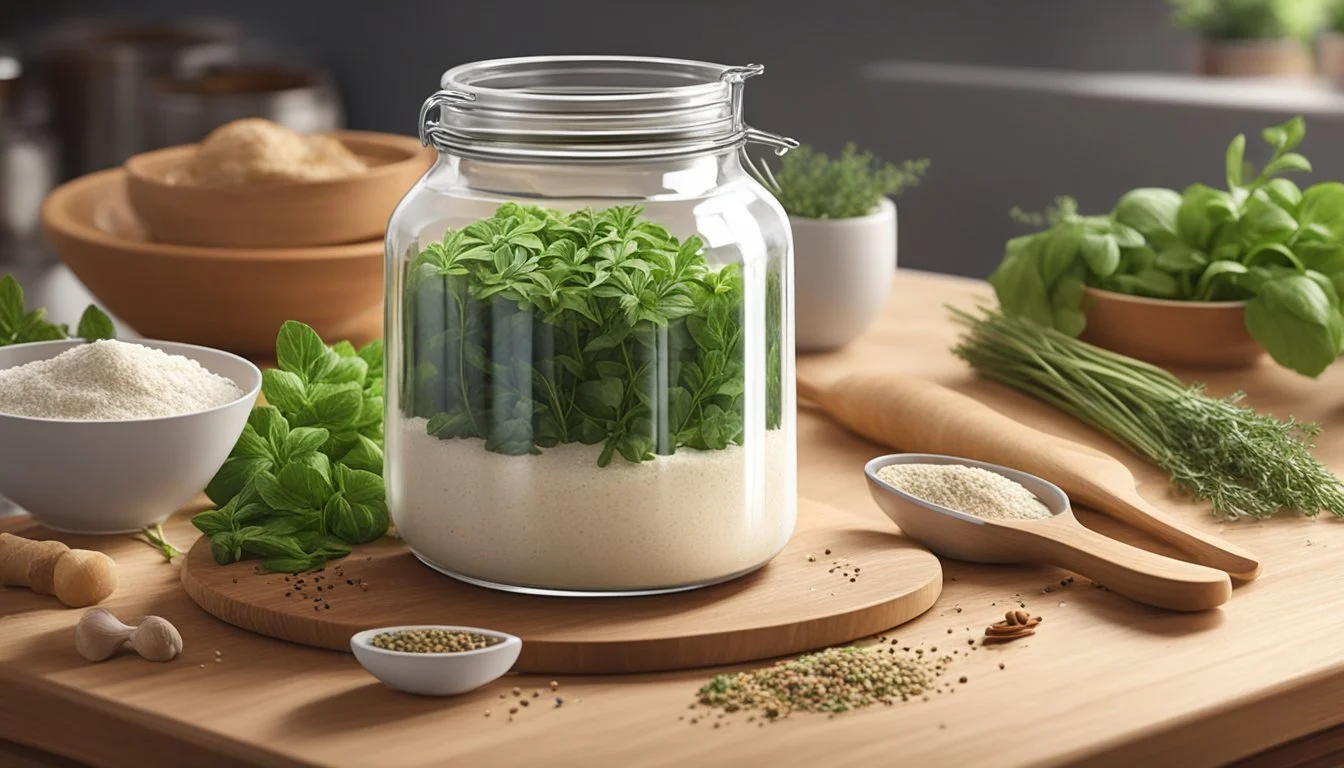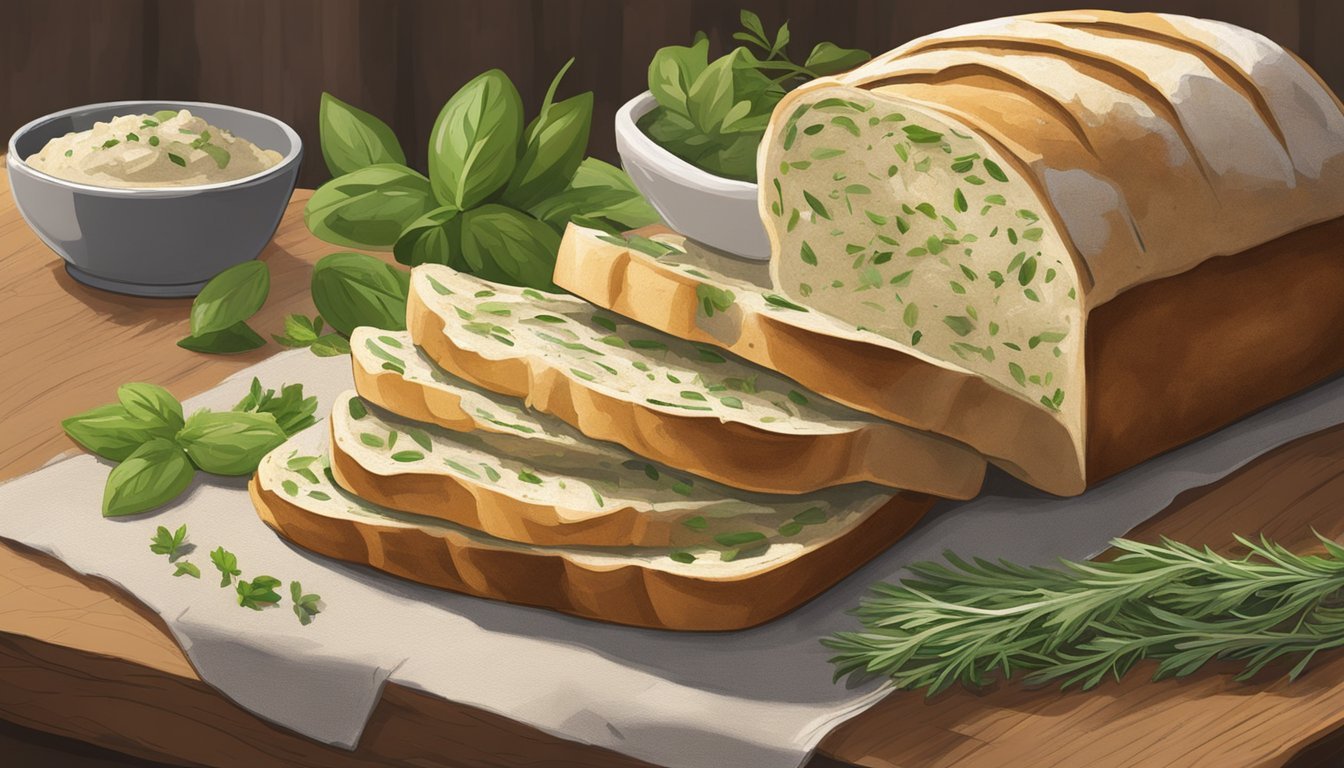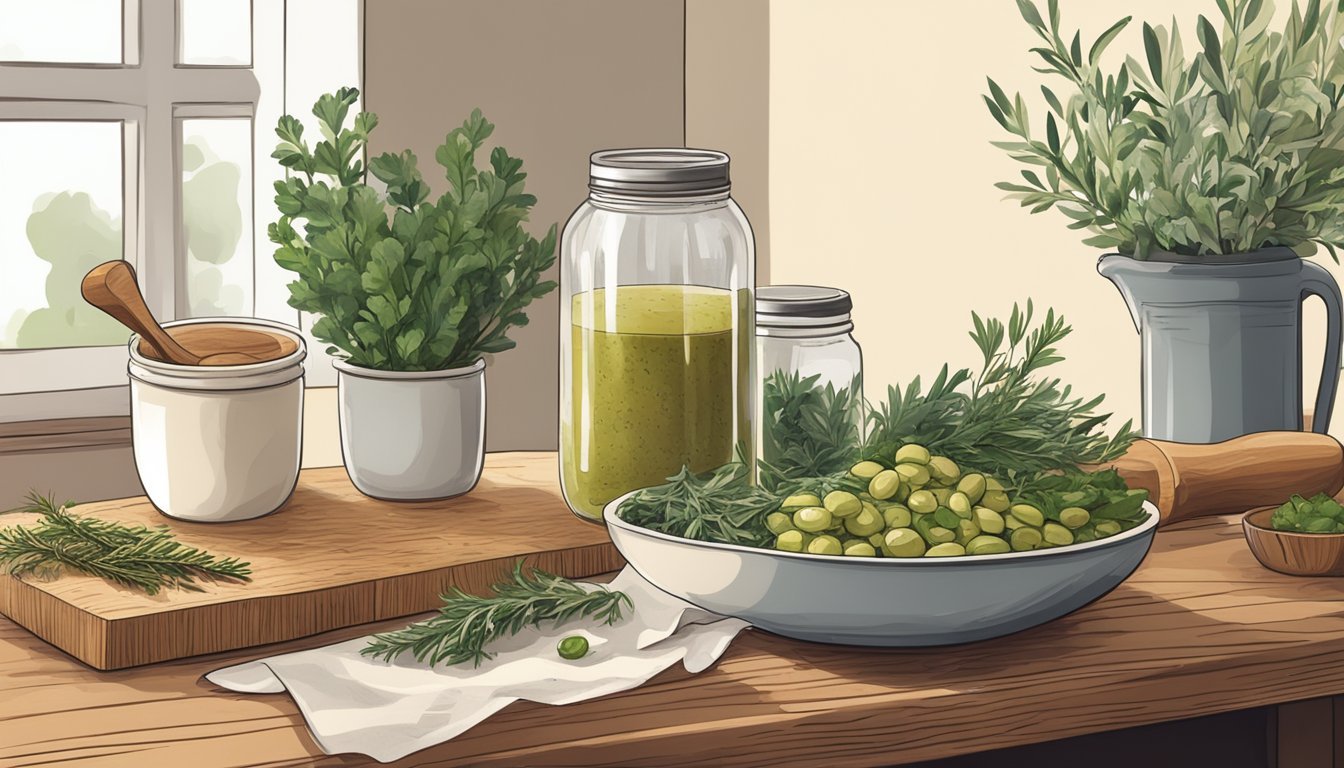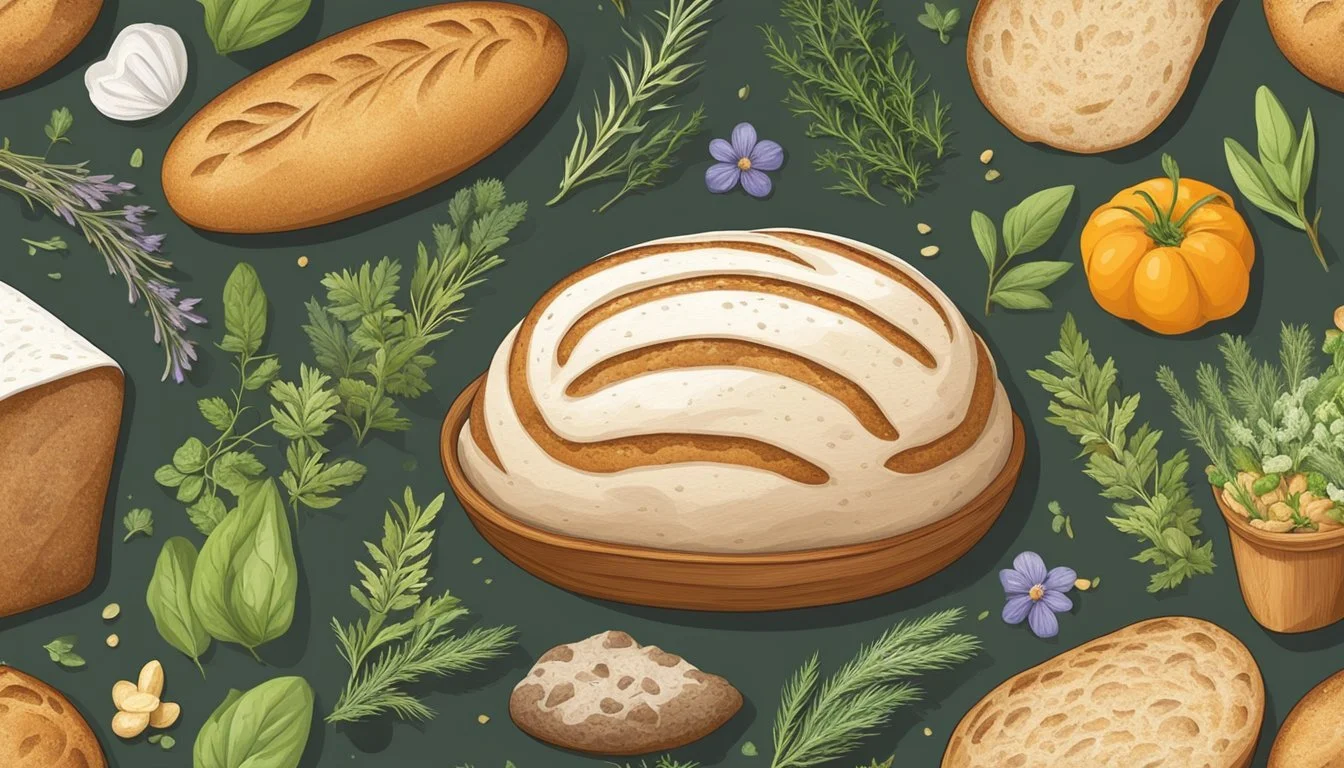Sourdough and Seasonal Herbs
Enhancing Your Bread with Fresh Flavors
Sourdough bread (What wine goes well with bread?), with its tangy flavor and rustic charm, has long been a staple in many households. The bread's distinct taste comes from fermentation, a process that not only aids in leavening the dough but also contributes to its unique flavor profile. Incorporating seasonal herbs into sourdough bread offers an opportunity to infuse fresh, aromatic flavors that complement the bread's natural sourness.
Seasonal herbs, when added to sourdough, elevate the bread into a flavorful masterpiece that captures the essence of the current season. The use of herbs such as sage, thyme, oregano, and rosemary can enhance the bread's aroma and taste profile. These herbs can be mixed into the dough or used as toppings, allowing bakers to experiment with various combinations and intensities of flavor.
The integration of herbs in sourdough making is not only about adding taste but also about embracing local and seasonal produce. Utilizing herbs that are fresh and available locally supports sustainable baking practices and ensures the bread is enriched with the highest quality of natural ingredients. Bakers may choose to harness the vibrant flavors of herbs at their peak, adding layers of flavor that store-bought breads often lack.
Understanding Sourdough Basics
Sourdough bread, a beloved staple with a distinct tang, owes its qualities to a fermentation process. Key ingredients include flour, water, and the sourdough starter—a mixture teeming with wild yeasts and beneficial bacteria that facilitate fermentation.
The process starts with mixing ingredients to form the dough, using a flour ratio and hydration level precise to the baker's preference, often detailed using baker's percentage. This percentage represents the flour's weight as 100%, with all other ingredient weights as relative measures — for instance, 70% water to flour ratio suggests 700 grams of water for 1000 grams of flour.
Hydration impacts the bread dough's texture and gluten development; high hydration leads to a more open crumb structure and lighter bread. After mixing, the dough undergoes bulk fermentation. This crucial phase not only allows the yeast to produce gases, causing the dough to rise, but also for the development of flavor and strength within the dough.
During this period, stretch and fold techniques are often used to enhance gluten structure and even distribution of gases and temperature. The baker should be attentive to the dough's growth and textural changes, which signal the end of fermentation. Once bulk fermentation is completed, the dough can be shaped, then proofed before baking. With sourdough, patience is paramount since the process unfolds over several hours or even days, unlike bread made with commercial yeast.
Bakers often express sourdough's versatility by incorporating various ingredients; seasonal herbs can contribute a unique flavor dimension tailored to personal tastes or times of year. This creative aspect of sourdough baking allows bakers to continually experiment and refine their artisanal loaves.
Creating Your Sourdough Starter
To craft an active sourdough starter, one begins with a simple combination of flour and water. This will be left to ferment, a natural process during which wild yeast and bacteria cultivate the starter, endowing it with the power to make bread rise. A nutritious flour, such as whole wheat or rye, is ideal for the initial mix because it is rich in micronutrients that promote fermentation.
The process unfolds over several days, typically about five to seven, during which the mixture must be cared for and fed regularly. Below is a brief guide to embarking on this foundational baking journey:
Day 1: Initial Mix
Whole wheat flour: 100g
Cool water (60°F to 70°F): 100g
Mix the flour and water together until it forms a thick, but smooth batter. It should have the consistency of thick pancake batter. Cover loosely and allow it to sit at room temperature (70°F to 75°F) for 24 hours.
Days 2-5: Feeding Routine
Daily discard: Remove about half of the starter
Daily feeding: Add 100g of flour and 100g of water
Discard the appropriate amount and mix in the new flour and water. Stir vigorously to incorporate air which helps with yeast activity.
After feeding, mark the level on the container to monitor growth.
Cover and let the starter rest at room temperature for 24 hours between feedings.
Note: On day 2 or 3, the starter may show few signs of activity; however, by days 4 and 5, it should be bubbly, may have doubled in size, and emit a tangy, but pleasant aroma that will contribute to the flavor of the bread.
The sourdough starter is considered mature and ready for baking bread when it has a frothy and foamy texture, a strong yeast aroma, and is capable of doubling in size between feedings. This is now an active sourdough starter and will impart its unique flavors that are characteristic of sourdough bread.
To maintain the starter's health, continue the feeding routine, adjusting the timing and flour to water ratios based on ambient temperature and desired tartness of the final product. Each starter develops its own personality, becoming more flavorful over time, and can last indefinitely with proper care.
Incorporating Seasonal Herbs
Adding seasonal herbs to sourdough bread infuses it with distinctive flavors that elevate the taste experience with every bite. When selecting herbs, one should consider their impact on the overall flavor profile. Savory herbs like rosemary, thyme, and oregano complement the sourdough's natural tang, providing a rustic and aromatic touch to the loaf.
Rosemary imparts a pine-like fragrance, perfect for a winter-inspired loaf.
Thyme, with its subtle, earthy essence, pairs well with other herbs for a layered flavor.
Oregano offers a bold, classic Italian seasoning to the bread.
To incorporate fresh herbs (how long do fresh herbs last?) effectively:
Dice or chop the herbs finely to maximize their flavor distribution throughout the dough.
Infuse oils with herbs like rosemary or oregano to create a subtle undertone.
Add herbs during the initial mixing to allow the flavors to meld with the fermentation process.
For a more prominent herb presence, fold basil leaves or other larger herbs into the dough during shaping.
Finally, attention to hydration levels is crucial, as additional ingredients may alter the dough's moisture balance. A base dough hydration of 65% is recommended, adjusting as needed to ensure a workable consistency when adding fresh herbs. Using herbs at their peak season ensures maximum flavor and freshness, transforming a simple sourdough into an artisanal masterpiece, brimming with natural, herbal undertones.
Selecting Flavorful Add-ins
When crafting sourdough bread, selecting quality ingredients is paramount to achieving a delicious and aromatic loaf. One should consider the compatibility of flavors and the moisture content of add-ins, as they will impact the dough's hydration and texture.
Herbs and Aromatics Herbs such as rosemary, thyme, and sage impart robust flavors. Garlic adds a pungent kick, often complemented by olives or sun-dried tomatoes. When using dried herbs, remember they are more concentrated than fresh.
Cheeses Incorporating cheese provides a rich, savory note. Popular choices include feta and stronger varieties like sharp cheddar, which pair well with olives, particularly kalamata.
Nuts and Seeds To add a nutritious crunch, one may include nuts and seeds. Sesame seeds, pumpkin seeds, and walnuts are excellent for texture and taste. Ensure they are evenly distributed within the dough.
Fruits Dried fruits like raisins or apricots lend a sweet contrast to the sour tang of the bread. Lemon zest can offer a refreshing citrus undertone. When adding fruits, make sure they are well-drained or dried to prevent excess moisture.
Vegetables Finely chopped vegetables such as zucchini or mushrooms should be pre-cooked to remove moisture and concentrate flavors.
Table 1: Suggested Pairings
Add-In Pairing Suggestion Note Olives Cheese, Garlic Balance with savory notes; watch salt content. Sun-dried Tomatoes Olive Oil, Feta Rich flavor; chop finely to distribute well. Sesame Seeds Nuts and Seeds Adds crunch; toast for enhanced flavor. Pumpkin Spices, Dried Fruit Complements sweetness; ensures it's well-puréed. Coconut Lemon, Dried Fruit Tropical vibe; consider flaked for distinctive texture. Cheese Herbs, Aromatics Matches intensity of herbs and spices with creamy texture
Balance is key in flavor pairings. Experimentation is encouraged to find the perfect fusion of taste and texture preferences.
Techniques for Incorporating Add-ins
When introducing mix-ins into sourdough bread, timing and technique are crucial to maintain the dough’s integrity while infusing flavor. Mix-ins should be added during the later stages of dough development, often during the final series of stretch and folds, to ensure even distribution without compromising the dough's structure.
For dry ingredients, such as herbs or seeds:
They must be evenly spread over the stretched dough.
The add-ins are then folded into the dough to embed them.
For wet ingredients or those with moisture, such as olives, roasted garlic, or sun-dried tomatoes:
Soak such add-ins in water to minimize extra moisture;
Drain thoroughly before adding them to the dough;
Incorporate at the stretch and fold stage, taking care to maintain dough consistency.
For ingredients prone to making the dough wet, like fresh fruits:
Reduce the dough's hydration slightly to counterbalance the moisture from the fruits;
Add these fruits during folding or just before the final shaping.
Table: Impact of Add-ins
Add-in Type When to Incorporate Technique Dry Items Stretch and fold stage Evenly spread, then fold Wet Items Stretch and fold stage Soak, drain, then fold Fresh Fruit Folding or shaping stage Adjust dough hydration
A key to success is the consistency of the sourdough. Add-ins should not alter the fundamental texture of the bread. It's pertinent to be gentle during the incorporation process to avoid tearing the gluten network. One’s hands might be lightly wetted to handle sticky add-ins like cheese or candied fruits, helping to prevent the dough from sticking.
Adjusting Hydration for Add-ins
When introducing wet additions like fresh herbs into sourdough, one must account for the change in hydration. Hydration refers to the flour to liquid ratio in the dough, and it's a critical factor in achieving the desired texture of your loaf.
Fresh herbs and other ingredients can release moisture into the dough. To compensate, bakers should evaluate the water content of these add-ins and adjust the liquid in the recipe accordingly. Reducing the initial water content is advisable to maintain the balance.
During bulk fermentation, it's pertinent that the dough maintains its structure. A dough too wet due to unaccounted moisture from add-ins may result in overproofing or an inability to hold shape. Consequently, the baker should pay close attention to the dough's consistency, performing adjustments as needed.
Table 1: Suggested Adjustments for Herbs
Herbs Estimated Water Reduction Fresh Basil 5% Sage 3% Rosemary 4%
To Calculate Adjusted Hydration:
Subtract the estimated water content of herbs from the original liquid measurement.
Mix the dry ingredients and herbs thoroughly before slowly incorporating the adjusted liquid amount.
Maintaining the correct hydration ensures a sourdough loaf that is light and airy with a crusty exterior. The baker’s experience and careful observation are crucial in this process, using the feel of the dough as a guide.
Remember, when altering a recipe, document the changes. This practice helps refine the process for consistent results with each bake.
Baking with Oils and Fats
In the world of sourdough, the traditional quartet of flour, water, starter, and salt often takes the spotlight. However, incorporating oils and fats can transform the final loaf in both flavor and texture. Oils, like olive oil, add a fruity twist and contribute to the nutritional value by introducing heart-healthy monounsaturated fats. These fats can help reduce LDL cholesterol levels when included in a balanced diet.
Butter is another popular choice. It imparts a rich, creamy flavor and, when used judiciously, can tenderize the crumb. Using fats in sourdough isn't just about the taste; they even affect the characteristics of the dough. Below are brief effects of including fats and oils in sourdough:
Fat Type Effects on Dough Contribution to Texture Olive Oil Increases extensibility Enhances softness Butter Impedes gluten formation slightly Yields a tender crumb
When incorporating fats into sourdough, bakers should mix them into the dough to ensure even distribution. One should note that fats can alter the hydration of the dough, which may necessitate adjustments in water content for maintaining the desired consistency.
A moderate approach is recommended, as too much fat can weigh down the loaf, potentially impeding yeast activity and gluten development. Bakers often adhere to a general guideline of not exceeding a baker's percentage of 20% fats relative to the flour weight in the recipe. This balance helps maintain the structural integrity of the loaf while still reaping the benefits that oils and fats offer.
Sweet vs Savory Combinations
Incorporating herbs into sourdough bread allows bakers to create a diverse range of flavors suited to individual tastes. When it comes to sweet and savory combinations, the key lies in balance and harmony between the added ingredients.
Sweet Additions:
Sweet flavor additions transform a simple loaf into a delightful treat. Fruit-based inclusions such as diced apricots, berries, and raisins introduce natural sugars, while infusions of vanilla or date pieces can add depth. For a more indulgent twist, chocolate chips or white chocolate pieces meld with the dough to create pockets of sweetness. Bakers sometimes combine these with a dusting of cocoa powder for an even richer flavor profile.
Table 1: Sweet Combination Suggestions
Ingredient Suggested Pairing Chocolate Chips Dark chocolate with dried cherries White Chocolate White chocolate with apricots Fruit Raisins with a hint of cinnamon
Savory Blends:
Savory sourdough embodiments often utilize aromatic herbs and spices. The natural flavors of the dough are enhanced with the addition of ingredients like rosemary, thyme, or garlic. These savory elements can complement dishes at any meal and are often sculpted by personal preference and the seasonality of herbs.
Table 2: Savory Combination Suggestions
Ingredient Suggested Pairing Herbs Rosemary with sea salt Spices Garlic with cracked black pepper
When choosing between sweet and savory, consider the occasion and meal pairing. Sweet sourdoughs are often seen as a dessert or snack, while savory loaves can elevate a main course or serve as a satisfying appetizer. Experimentation is encouraged as bakers refine their unique palate for flavor combinations within their sourdough creations.
Designing Artisan Loaves
Creating artisan sourdough loaves with a twist of seasonal herbs is a delightful way to fuse flavor and craftsmanship. The bread's shape and ear are crucial for its visual appeal and baking quality. Mindfully incorporating herbs and shaping the dough can yield stunning results.
Shaping with Herbs
Artisans often choose a rectangle as the foundational shape for their loaves, allowing for uniform slices. When adding fresh herbs into the mix, one should uniformly distribute them during the dough folding process to ensure every slice has a burst of flavor.
Baking Techniques
To achieve a perfectly baked artisan sourdough, one must pay close attention to the baking environment:
Preheat: A Dutch oven comes highly recommended for its ability to mimic a professional baker's oven, providing consistent heat and an ideal crust. Artisans should preheat it to around 450 degrees Fahrenheit.
Baking: Placing the loaf inside a Dutch oven with the lid on for the first portion of the baking time traps steam and contributes to the bread's rise and ear formation. After this, removing the lid allows the crust to develop a rich color and crisp texture.
Cooling
Once baked, the loaf should rest on a wire rack to cool. This pause allows the bread to complete its cooking process and develop the proper texture and crust.
By combining these methods with seasonal herbs, bakers can confidently create artisan sourdough loaves that are as flavorful as they are visually appealing.
Advanced Sourdough Techniques
When crafting a sourdough loaf with herbs, advanced techniques can elevate both flavor and texture. Mastery over these methods ensures a bake that's both aromatic and structurally sound.
Stretch and Folds
Proper gluten development is crucial, and stretch and fold techniques aid this process. Bakers perform a series of folds during the bulk fermentation to strengthen gluten networks without overworking the dough. Typically, 3 to 4 folds spaced out over 30-minute intervals help uniformly incorporate seasonal herbs while maintaining the dough structure.
Bulk Fermentation
The length of bulk fermentation directly impacts the loaf's flavor and texture. Expert bakers monitor the dough's rise, aiming for an approximate 30-50% increase in volume. This phase allows the dough to ferment and the herbal flavors to meld seamlessly into the bread matrix.
Proofing
After shaping, proofing is the final step where the dough rises until it's airy and ready to bake. The proofing period should be monitored carefully; over-proofing can lead to a dense loaf, whereas under-proofing might not give the loaf enough lift.
Fermentation Control
Controlling the temperature during fermentation can modify the sourness of the bread. Cooler temperatures favor acetic acid production for a tangier taste, while warmer conditions produce a milder lactic acid. Incorporating seasonal herbs during the initial mixing ensures a more pronounced flavor profile in the final loaf.
Key Phase Technique or Consideration Impact on Loaf Stretch and Folds Even distribution of ingredients Enhanced texture and ingredient spread Bulk Fermentation Volume increase monitoring Improved flavor and structure Proofing Avoid over/under-proofing Ensures optimal rise and texture Fermentation Temperature Adjust for desired sourness Balances flavor profile
Through these advanced sourdough techniques, bakers can manipulate fermentation, texture, and flavor—achieving the perfect symbiosis between dough and seasonal herbs.
Pairings and Serving Suggestions
When it comes to enhancing sourdough bread with herbs, the possibilities for pairings and serving suggestions are bountiful. A well-chosen herb can elevate the flavor of your loaf, and how you serve it can further accentuate these taste nuances.
Fresh Herbs: Incorporating fresh herbs such as rosemary, sage, thyme, or oregano directly into your dough will impart a fragrant and earthy tone. They pair beautifully with butter or olive oil for a simple yet satisfying serving option.
Bold Toppings: For a more intense herbal flavor, consider creating a crust with chopped herbs pressed gently into the top before baking. This method integrates well when the bread is used for sandwiches or served alongside pasta with pesto.
Serving Suggestions Pairing Ideas Garlic herb butter Fresh rosemary Olive tapenade Chopped olives Cheese platter Marjoram, dill
Flavor Infusions: Infusing your sourdough with finely diced olives will give the loaf a salty, briny taste that goes excellent with a range of cheese. A sourdough with olive and rosemary could shift a simple cheese platter into a more aromatic experience.
Olive Oil Dips: To heighten the herbaceous qualities of the bread, one may serve it with a bowl of olive oil mixed with a dash of balsamic vinegar and more of the same herbs used in the bread.
When crafting your loaf, remembering that each herb imparts its own unique flavor is crucial. Thus, choosing toppings and pairings that complement these tones, rather than overpower them, will ensure a harmonious taste experience.
Maintaining Sourdough Culture
Maintaining a healthy sourdough starter is essential for successful fermentation and flavorful bread. A well-kept starter is the soul of sourdough, yielding loaves with complex flavors and textures.
Hydration Levels: The hydration of a starter, commonly expressed as a baker's percentage, refers to the ratio of water to flour by weight. For instance, a 100% hydration starter consists of equal parts water and flour. This consistency is crucial for achieving the desired balance in sourdough bread.
Feeding Routines: Regular feedings are vital to keep the sourdough culture active. A typical feeding routine involves discarding a portion of the starter and replenishing it with fresh flour and water. They should honor these proportions:
Flour (grams) Water (grams) Frequency 100 100 Daily
In a cool environment, they may adjust the schedule to every other day. Conversely, more frequent feedings may be essential in warmer climates to prevent over-fermentation.
Ambient Conditions: Temperature affects the rate of fermentation. Sourdough cultures thrive at 75°F to 80°F (24°C to 27°C). Temperatures outside this range will slow down or accelerate yeast and bacterial activity, hence requiring adjustments to the feeding schedule.
Noticing Changes: Observant bakers notice signs of a healthy starter: consistent rising after feedings, a pleasant tangy aroma, and small bubbles dotting the surface. They should respond to changes in these indicators by adjusting feeding ratios or schedules to maintain starter vigor and ensure the fermentation process is on track.
A well-maintained starter translates directly into the quality of the sourdough bread, making the maintenance routine a foundation of excellent baking results.
Nutritional Information
Sourdough bread stands out for its unique fermentation process, which not only contributes to its distinct tangy flavor but also impacts its nutritional profile. A slice of sourdough typically contains around 120 to 150 calories, with variations depending on specific ingredients like herbs or nutritional yeast.
Caloric Content:
Calories per slice (approximate): 120-150
Nutrition Facts:
Carbohydrates: A significant source in sourdough, providing energy.
Fiber: Presence varies with the type of flour used; whole grain versions have more.
Proteins: Contained in moderate amounts; fermentation may enhance quality.
Vitamins: B-vitamins like folate and niacin can be prevalent due to fermentation.
The bread's nutritional yeast and seasonal herbs not only enhance flavor but also infuse the sourdough with additional nutrients:
Seasonal Herbs:
Vitamins: Herbs such as rosemary, thyme, and sage can offer a variety of vitamins.
Antioxidants: High in many herbs, contributing to overall health benefits.
Nutritional Yeast:
Vitamin B12: Often fortified with B12, it is a valuable addition for those with dietary restrictions.
Protein: Contains all nine essential amino acids, making it a complete protein.
Fiber content in sourdough can aid in digestion and contribute to a feeling of fullness, potentially aiding in weight management. However, when adding rich ingredients such as cheese or bacon to sourdough, one should consider the additional calories and fats introduced.
In summary, sourdough bread can be a nutritious option, enhanced by the health benefits of added herbs and nutritional yeast. Its composition of vitamins, fiber, and protein supports the value sourdough can bring to a balanced diet.
Creative Twists on Classic Recipes
When it comes to baking sourdough bread, the classic recipe serves as a canvas for a variety of creative additions. Seasonal herbs and well-paired ingredients can elevate the flavor profile of a traditional sourdough loaf, offering exciting variations for any occasion.
Jalapeño Cheddar Sourdough: For those who enjoy a spicy kick, incorporating diced jalapeño peppers and shredded sharp cheddar into the dough during the stretch and fold stage can result in a bread that's as fiery as it is flavorful.
Ingredients:
Jalapeño peppers (diced)
Sharp cheddar cheese (shredded)
Parmesan Herb Sourdough: A more subdued but equally aromatic option involves mixing grated Parmesan cheese and a blend of dried herbs such as rosemary, thyme, and oregano into the dough.
Ingredients:
Parmesan cheese (grated)
Mixed herbs (dried or fresh)
Pumpkin Sourdough Bread: Embrace the flavors of fall by adding canned pumpkin puree into your sourdough mixture. This not only gives the bread a subtle sweetness and vibrant color but also adds moisture and softness to the crumb.
Ingredients:
Pumpkin puree (canned or fresh)
Chocolate Sourdough Bread: For a delightful twist, incorporating chunks of dark chocolate or cocoa powder into your dough can transform your sourdough into a sweet, decadent treat.
Ingredients:
Dark chocolate (chunks or chips)
Cocoa powder (optional)
Garlic Sourdough Bread: Infusing the dough with minced garlic or a swirl of garlic herb butter before shaping can make for a savory and aromatic loaf perfect for accompanying meals or as a standalone snack.
Ingredients:
Garlic (minced or as a compound butter)
These variations on classic sourdough bread recipes allow bakers to explore a wide range of flavors. Whether one is drawn to tangy cheese, earthy herbs, sweet chocolate, or the bold bite of garlic, there's a creative twist out there to satisfy every palate.
Tips for the Perfect Loaf
When baking sourdough bread infused with seasonal herbs, aiming for the perfect loaf involves several key steps.
Hydration Matters: The dough's hydration level is pivotal in determining its texture. Starting with a dough that has about 65% hydration offers a balance that can accommodate additional ingredients like fresh herbs.
Incorporate Fresh Herbs Thoughtfully: One must incorporate herbs such as rosemary, thyme, or basil into the dough during the stretch and fold stage to ensure even distribution without compromising the dough structure.
Using the Right Oven Temperature: Preheat the oven and maintain the correct baking temperature, typically around 400 degrees Fahrenheit, to achieve a well-baked loaf with a desirable crust.
A summary of the steps to consider:
Prepare the Dough: Begin with a 65% hydration level for easy incorporation of herbs.
Mixing in Herbs: Add finely chopped herbs during the dough's stretch and fold phase.
Baking With Steam: Introduce steam in the oven during the initial baking period to assist with the oven spring and formation of a crispy crust.
Testing for Doneness: Assess the loaf's readiness by its internal temperature, which should reach about 210 degrees Fahrenheit, and by the hollow sound when tapped on the bottom.
By keeping these tips in mind, the baker can ensure their herbed sourdough bread possesses a delightful aroma, a complex taste profile, and an appealing texture, rendering it both delicious and visually enticing.
















